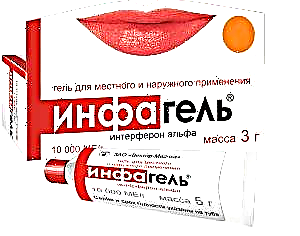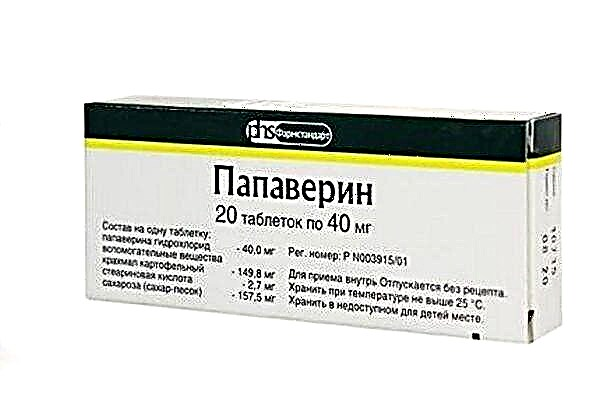
For bacterial infections, doctors prescribe effective antibiotics for children. Preparations in liquid form are especially popular, because the suspension is easier to dose for babies, and it is easier for a child to swallow. One of the effective antibacterial agents in this form is Zinnat. When should it be given to a child, can it negatively affect the health of children and how is such a medication properly dosed?

Release form
Suspension Zinnat is prepared from granules placed in a bottle in the amount of 1.25 g. A measuring glass and a dosage spoon are attached to a glass bottle containing the medicine.
The granules themselves look like grains with different sizes and irregular shapes, up to 3 millimeters in size. They are white in color, so after adding water, a white suspension is obtained, which may have a light yellow tint and has a characteristic fruit smell.
The medicine is also produced in tablets that cannot be broken. They are prescribed only to children who can swallow this form of medicine.

Composition
The main component of the suspension is cefuroxime in the form of axetil. This antibiotic contains 125 mg for every 5 milliliters of medication. To make the medicine sweet, sucrose and sweeteners such as aspartame and acesulfame potassium were added to its composition. For the scent, the preparation has a tutti-frutti flavoring agent. In addition, the granules include xanthan gum, stearic acid and povidone K30.

Operating principle
The drug is a representative of cephalosporin antibiotics and belongs to the second generation. It has activity against a fairly large number of pathogens, including microbes that produce beta-lactamases, so such a suspension can be prescribed if ampicillin or amoxicillin is resistant.
Zinnat has a bactericidal effect on microbes, acting on the synthesis of bacterial cell walls.
The medicine destroys:
- Escherichia coli.
- Hemophilic sticks.
- Gonococci.
- Klebsiella.
- Proteus.
- Providence.
- Staphylococcus aureus.
- Epidermal staphylococci.
- Pyogenic streptococci.
- Pneumococci.
- Group B streptococci.
- Peptostreptococci.
- Peptococci.
- Gram-negative and gram-positive rods, including bacteroids and fusobacteria.
- Borrelia.

The drug is inactive against pseudomonads, listeria, legionella, enterococci, citro- and enterobacter and some other microbes. The medicine may not work on certain strains of clostridia, staphylococci or proteus, therefore, before treatment, it is advisable to conduct a test that will determine the sensitivity of the pathogen to cefuroxime.
Indications
The suspension is prescribed for bacterial infections caused by a pathogen sensitive to cefuroxime:
- With tonsillitis, otitis media, pharyngitis and other diseases affecting the upper respiratory tract.
- For urethritis, cystitis, or a bacterial kidney infection.
- With pyoderma, boils and other skin lesions.
- With gonorrhea.
- With Lyme disease.
- With bacterial bronchitis or pneumonia.

From what age is it allowed to take?
Zinnat in liquid form is prescribed for babies who are 3 months old. The use of the drug in newborns is not recommended. The tablet form can be used over the age of 3 years if the child does not protest against the tablets and can safely swallow them.

Contraindications
Suspension Zinnat should not be used in the treatment of children who have:
- There is an intolerance to cephalosporins.
- Revealed phenylketonuria.
The increased attention of the doctor when prescribing such a drug requires the detection of kidney pathology and diseases of the gastrointestinal tract in a child, especially if high doses are used. Since the suspension contains sucrose, this must be taken into account when treating children with diabetes.

Side effects
Zinnat suspension therapy can cause in a child:
- Allergic reaction. The most common manifestation is a rash on the skin, a little less often - itching or hives. In isolated cases, drug fever may appear.
- Candidiasis. This side effect is associated with the suppression of not only harmful, but also beneficial microorganisms that interfere with the development of Candida fungi.
- Loose stools, abdominal pain, or nausea. Rarely, the suspension provokes vomiting or the development of colitis.
- Changes in blood counts. Most often, an increased number of eosinophils is detected, a little less often - leukopenia and thrombocytopenia. Occasionally, the child's body reacts to the drug with hemolytic anemia.
- Headache or dizziness.
- Liver damage which are often manifested by a temporary increase in enzyme activity, but can be represented by cholestatic jaundice or hepatitis.

Instructions for use and dosage
To dilute the granules with water, you need to use a measuring glass, pouring boiled water into it up to the mark corresponding to 37 ml. After shaking the granules to make them more crumbly, pour the water into the bottle and close it with the lid. After inverting the bottle, shake it for about 15 seconds, then turn it over to its normal position and shake it again.
The child can be given the medicine undiluted or just before use, dilute the required amount of the suspension with a small volume of milk or fruit juice. Hot liquid or food should not be mixed with the preparation.
For many children, the doctor prescribes Zinnat in a fixed dosage, which for most infections is 125 mg twice a day. At the age of over 2 years with severe infections, a single dose can be increased to 250 mg, which corresponds to a daily dosage of 500 mg.
In some cases, pediatricians calculate the dosage of the suspension by the weight of the small patient. A single dose of the drug under the age of 12 is 10 mg for each kilogram of the child's body weight, and for severe infections - 15 mg / kg. Having determined the required amount of the active substance, it is given to children twice a day.
For example, a child at the age of 1 year weighs 12 kg, then a single dose of Zinnat for him will be 120 mg (one scoop), and for otitis media or other severe infections, 180 mg (1.5 scoops) should be given.


Overdose
A suspension taken in too large a dose can provoke nervous excitement and convulsions. Treatment of children with an overdose is usually symptomatic, and in severe cases, dialysis is prescribed.

Interaction with other drugs
- Zinnat should not be combined with medications whose action is aimed at reducing the acidity of juices in the stomach, as this affects the bioavailability and absorption of cefuroxime.
- If the suspension is administered together with loop diuretics, it will lead to a decrease in the excretion of the drug through the kidneys and increase its concentration in the blood.
- Combined use with aminoglycosides increases the risk of toxic effects of cefuroxime on the kidneys.

Terms of sale
To buy Zinnat granules at a pharmacy, you first need to get a prescription from your doctor. The average price of one bottle of this medication is 260-270 rubles.
Storage conditions
Granules in a closed bottle can be stored at home at temperatures below +30 degrees during the entire shelf life, which is 2 years for this form of medicine. When the suspension is already prepared, it must be kept in the refrigerator (the storage temperature of such a medicine is from +2 to +8 degrees) for no longer than 10 days. It is important that the bottle is out of reach of a small child.

Reviews
Most of the reviews from parents about the use of Zinnat suspension in their children are positive. Mothers confirm the high effectiveness of such an antibiotic for otitis media, pharyngitis, furunculosis, pyelonephritis and other infections. Children usually do not protest against its taste, and for dosing mothers they often use a syringe from Nurofen or another drug in suspension. As for negative reviews, the most often complain of side effects, for example, from the digestive system.

Analogs
Instead of Zinnat, it is possible to use other drugs containing cefuroxime. These include Zinacef, Axetin, Cefurus, Cefuroxime, Axosef, Cefurabol, Xorim, Cefurosin and other drugs. All of them are presented in an injectable form and only a few are available in tablets. If an analogue of Zinnat in suspension is required, the doctor may prescribe other cephalosporins or penicillin antibiotics, for example, Suprax, Pantsef, Augmentin, Hikontsil, Amosin or Ekoklav.

In the following video, the popular children's doctor Komarovsky talks in detail about antibiotics, what they are for and when they should be used.



